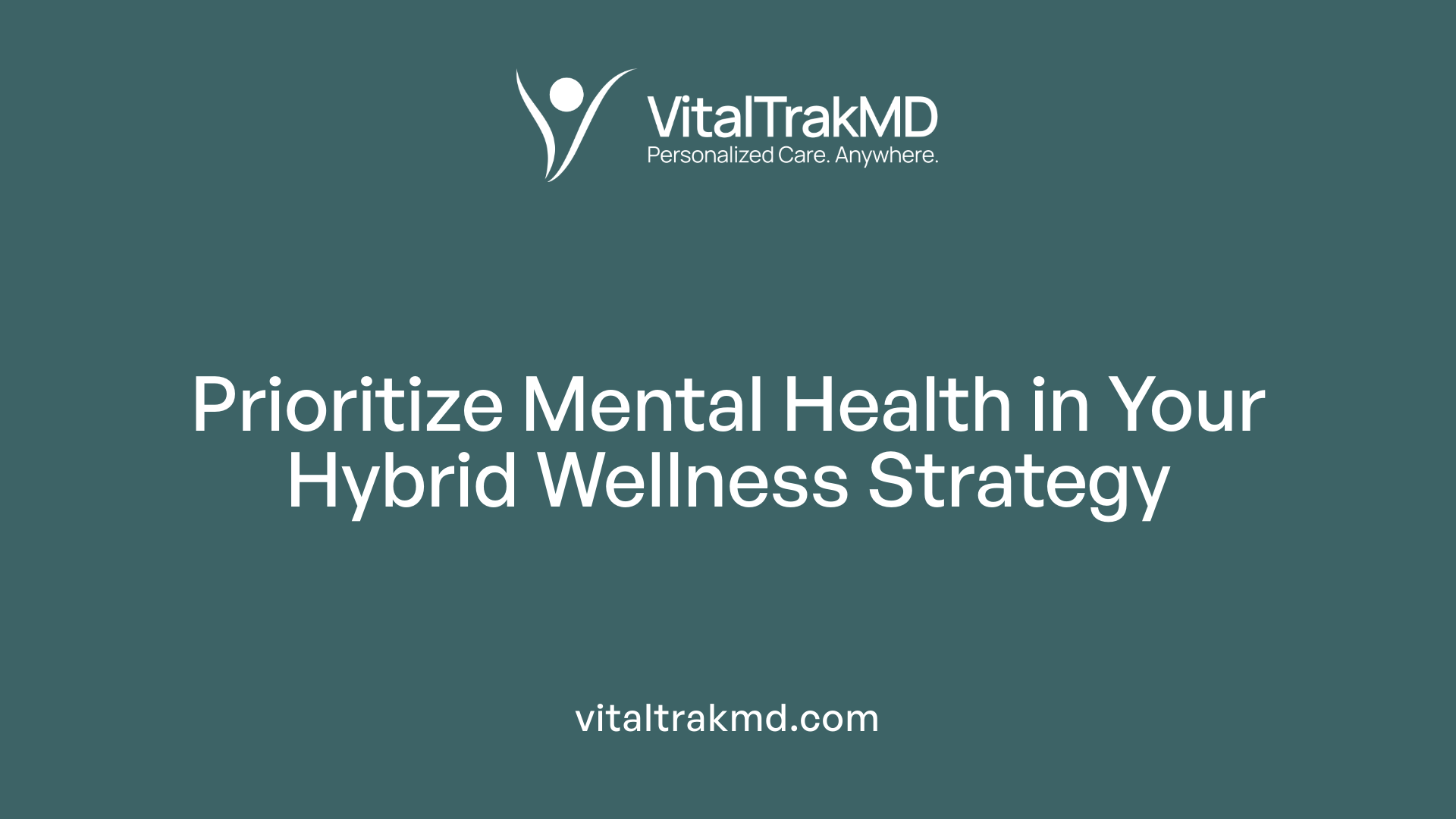How Hybrid Healthcare Encourages Proactive Health Discussions

The Shift Towards Integrated Healthcare Models
As healthcare increasingly embraces technology and holistic approaches, hybrid healthcare models combining in-person and digital tools are transforming wellness and proactive health discussions. These models cultivate deeper employee engagement, foster sustainable behavior change, and ultimately improve health outcomes within workplace wellness programs and beyond.
Core Components of Effective Wellness Programs in a Hybrid Model

What are the key components of effective wellness programs?
Effective wellness programs typically focus on physical activity, nutrition guidance, mental health support, and preventive health screenings. These core elements help employees maintain and improve their wellbeing, driving productivity and reducing healthcare costs.
Beyond these basics, many programs include biometric screenings, health risk assessments, smoking cessation, stress reduction techniques, and financial wellness initiatives designed to encourage proactive health management.
How do digital tools integrate into wellness programs?
Digital health platforms enhance wellness programs by providing wellness apps, online coaching, and disease management modules. These tools facilitate personalized engagement, allow for data-driven insights, and support behavior change. Telehealth services and remote monitoring offer convenience and connect employees to multidisciplinary care without extensive travel.
What legal and ethical considerations should be accounted for?
Wellness programs must adhere to legal frameworks such as the Americans with Disabilities Act (ADA), the Genetic Information Nondiscrimination Act (GINA), the Health Insurance Portability and Accountability Act (HIPAA), and the Affordable Care Act (ACA). These laws ensure that participation is voluntary, data is confidential, and programs do not discriminate against employees.
What strategies effectively engage employees?
Successful wellness initiatives emphasize clear, transparent communication and ongoing evaluation. Personalized and adaptive digital communication—such as telephonic coaching and app notifications—help maintain engagement. Encouraging participation through incentives, integrating wellness into corporate policies, and offering flexible access points foster sustained involvement.
| Component | Description | Example Implementation |
|---|---|---|
| Physical Activity | Encouraging regular exercise and movement | Step challenges, gym memberships |
| Nutrition Guidance | Education on healthy eating habits | Nutritional workshops, plant-forward diets |
| Mental Health Support | Providing resources for mental wellness | Mind-body practices, digital therapy apps |
| Preventive Screenings | Early detection of health risks via assessments | Blood pressure, cholesterol screenings |
| Digital Integration | Use of apps, telehealth, remote monitoring | Wellness apps, telephonic coaching |
| Legal Compliance | Adherence to ADA, GINA, HIPAA, ACA regulations | Confidential data handling |
| Employee Engagement | Communication, incentives, flexible policies | Personalized messages, health challenges |
Combining Lifestyle and Medication: Keys to Sustainable Weight Loss through Wellness Programs

How can wellness programs contribute to sustainable weight loss?
Wellness programs play a crucial role in supporting sustainable weight loss by encouraging comprehensive lifestyle changes. These programs emphasize nutritious eating, regular physical activity, and behavioral support tailored to individual needs. For example, initiatives focusing on whole-food, plant-forward diets coupled with at least 150 minutes of weekly physical activity have been shown to yield modest yet meaningful weight loss and health benefits.
Behavioral coaching, delivered through personalized digital communication and telephonic support, strengthens adherence to healthy habits. Studies in primary care settings with electronic health record messaging indicate that about 60% of participants successfully lost weight within six months, with 15% achieving a loss of 5% or more of their body weight.
What is the role of lifestyle modifications?
Lifestyle modifications form the foundation for managing obesity alongside other treatments. Nutritional education helps employees build sustainable eating habits that improve their metabolic health. Physical activity and mental wellness components reinforce this foundation by reducing stress and inflammation, which are contributors to obesity and its related conditions, such as type 2 diabetes and cardiovascular disease.
How have modern medications impacted weight loss strategies?
The advent of GLP-1 receptor agonists marks a transformational advance in medical obesity management. These medications regulate appetite, insulin response, and satiety, resulting in significant weight loss of 10-15% over a year. Beyond weight reduction, GLP-1 therapies improve blood sugar control, reduce insulin dependence, and lower risks of heart attacks and strokes. They also have promising effects on liver health, particularly in reversing nonalcoholic steatohepatitis (NASH).
How is telehealth integrated into wellness programs?
Telehealth and digital health tools extend and personalize wellness programs, enabling remote patient monitoring, frequent check-ins, and prompt intervention. Mobile apps and virtual coaching optimize motivation and adherence, aiding long-term weight management. Telehealth-driven programs offer convenient access to multidisciplinary care, including preventive screenings and lifestyle coaching without the need for extensive travel.
This integrated approach—melding lifestyle changes, medication, and digital support—has demonstrated effectiveness and feasibility in real-world settings, promoting sustainable weight loss and improved health outcomes over time.
| Aspect | Description | Example or Impact |
|---|---|---|
| Lifestyle Modifications | Diet, exercise, behavioral support | Whole-food, plant-forward diet; 150+ min/week physical activity |
| Modern Medications | GLP-1 receptor agonists | 10-15% weight loss, improved metabolic and liver health |
| Telehealth Integration | Digital coaching, telemedicine, remote monitoring | Increased adherence, convenience, early intervention |
| Wellness Programs | Holistic approach combining education, coaching, and medical care | Worksite programs; personalized nutrition and behavior change |
The Vital Role of Mental Health in Hybrid Wellness Models

What role does mental health play in wellness and weight management?
Mental health is crucial in supporting both overall wellness and successful weight management. Emotional states influence behaviors like eating habits, motivation to exercise, and adherence to treatment plans. For example, depression and anxiety can increase emotional eating or food addiction, which complicates weight loss efforts. Effective management of mental health improves self-esteem and resilience, fostering healthier lifestyle choices.
Integration into Primary Care
Mental health is increasingly embedded within primary care frameworks to provide comprehensive support for patients. Practices such as mind-body medicine are incorporated to address stress, anxiety, and other psychological challenges alongside physical health. This integrative approach ensures mental health considerations are part of ongoing wellness plans, enhancing outcomes for weight management and chronic disease prevention.
Digital Mental Health Tools
Digital platforms, including therapy apps and virtual support groups, expand access to mental health resources. These tools offer convenient, flexible support that can be seamlessly integrated into daily routines and wellness programs. They also complement traditional care by providing ongoing assistance for stress management, behavior change, and motivation, all essential for successful weight loss and maintenance.
Mind-Body Medicine Approaches
Mind-body medicine techniques such as meditation, yoga, and biofeedback help reduce stress and improve emotional regulation. These methods play a pivotal role in reducing barriers to healthy behavior changes, such as emotional eating triggered by stress or anxiety. Combining mind-body practices with nutritional education and physical activity creates a holistic foundation for lasting wellness.
Together, these mental health strategies form a vital component of hybrid wellness models—blending physical and psychological care through both in-person and digital solutions—to effectively support weight management and overall health.
Overcoming Challenges in Designing Effective Care Programs for Health Improvement

What are common challenges faced in designing care programs aimed at health improvement?
Designing effective care programs that improve health outcomes involves navigating several significant challenges.
Firstly, healthcare system integration is a major hurdle. Many organizations deal with fragmented healthcare systems, making it difficult to coordinate care seamlessly across multiple providers and care settings. Communication gaps during care transitions can result in inconsistent monitoring and follow-up.
Secondly, patient engagement challenges play a critical role. Encouraging ongoing involvement in wellness initiatives demands strategies like shared decision-making and personalized support, but patients often face barriers such as limited access, motivation issues, or health literacy constraints.
Thirdly, technology adoption hurdles slow progress. While tools like telehealth, digital coaching, and remote patient monitoring hold promise, healthcare organizations often grapple with outdated legacy systems, concerns about cybersecurity, and the complexity of integrating new digital solutions effectively.
Lastly, equity and cultural sensitivity are vital considerations. Persistent health disparities require care programs that accommodate diverse cultural backgrounds and social determinants to ensure all populations benefit equally.
Addressing these challenges requires a multifaceted approach including cross-sector collaboration, embracing digital health innovations carefully, ongoing patient-centered engagement, and a strong focus on equitable and culturally-informed care delivery. Advances like AI-enhanced telehealth and personalized wellness platforms promise to facilitate more integrated and effective health improvement programs in the future.
Hybrid Healthcare Technologies Facilitating Proactive Health Discussions
How do telehealth services contribute to prevention?
Telehealth plays a vital role in proactive health management by providing convenient access to preventive services and wellness programs. Key telehealth offerings include health screenings for blood pressure, cholesterol, and blood sugar; vaccinations; lifestyle coaching covering nutrition, fitness, and stress management; and mental wellness programs. Virtual check-ups enable early detection and timely intervention without requiring extensive travel, making it easier for individuals to integrate care into daily routines.
What roles do digital health platforms play?
Digital health platforms, such as those partnered with Vera Whole Health and Castlight, enhance employee engagement and support comprehensive wellness plans. They offer adaptive, personalized communication and coaching via mobile apps or telephonic support, empowering users to make sustained behavior changes. These platforms facilitate coordinated care by connecting patients with multidisciplinary healthcare professionals, ensuring tailored support for diverse health needs.
How does remote patient monitoring (RPM) improve health outcomes?
Remote patient monitoring tools enable continuous tracking of health metrics, supporting efforts in weight loss and chronic disease management. By allowing frequent check-ins and early problem detection, RPM fosters increased motivation and adherence to care plans. This approach complements intensive lifestyle interventions, leading to improved cardiovascular risk factors and successful weight management in pragmatic, real-world settings.
In what ways does AI enhance personalized care?
Advances in artificial intelligence (AI) and machine learning are driving the future of telehealth by enabling personalized prevention strategies. AI aids in analyzing complex health data, including genomics and biometric inputs, to create customized treatment plans. It supports diagnostic accuracy and optimizes intervention timing, ultimately improving health outcomes through more precise, adaptive care.
| Technology | Functionality | Benefits |
|---|---|---|
| Telehealth Services | Virtual screenings, coaching, mental wellness | Early detection, convenience, accessibility |
| Digital Health Platforms | Personalized communication and multidisciplinary integration | Sustained engagement, tailored support |
| Remote Patient Monitoring | Continuous health tracking and feedback | Motivation, adherence, early intervention |
| AI and Machine Learning | Data analysis, personalized diagnostics | Enhanced precision, predictive care |
Workplace Wellness as a Frontier for Hybrid Healthcare Innovation
How are employee wellness programs evolving in the workplace?
In 2021, over half of U.S. organizations (52%) offered wellness programs to their employees, signaling a growing recognition of health as a workplace priority. These programs go beyond simple health checks, incorporating nutritional education and health screenings to promote healthy eating and identify health risks early. Such initiatives aim not only to improve individual health but also to boost productivity and reduce healthcare expenses for employers.
What role does behavior change play in workplace wellness?
Successful wellness programs rely heavily on sustained behavior change. This is increasingly supported through primary care models integrated with digital tools. Ongoing engagement, tailored coaching, and regular monitoring help employees adopt and maintain healthier habits. Behavioral change models emphasize personalization and continuous support, which are critical components in preventing chronic diseases linked to lifestyle factors.
How do primary care partnerships enhance wellness initiatives?
Companies like Vera Whole Health collaborate with digital health platforms such as Castlight, combining primary care with technology to foster employee engagement. These partnerships create a hybrid healthcare approach where traditional medicine meets virtual platforms, enabling more accessible, effective wellness strategies. This integration helps employees access personalized care, from preventive screenings to digital therapy, strengthening overall health outcomes.
What is the importance of social and sustainable wellness in the workplace?
Modern workplace wellness programs recognize that health is holistic, extending to social connections and environmental factors. Community and digital platforms are employed to combat loneliness and promote social wellbeing, while sustainable wellness practices encourage eco-friendly products and corporate policies that align with planetary health. Such approaches acknowledge that employee health is intertwined with social and environmental wellbeing, enhancing both individual and organizational resilience.
The Future of Healthcare is Hybrid and Proactive
Hybrid healthcare models that integrate in-person care with advanced digital tools are reshaping wellness programs by fostering proactive health discussions and enabling sustainable health improvements. Through personalized approaches combining lifestyle, mental health, and medication support, these programs address complex health needs such as obesity while overcoming traditional barriers. Challenges remain, but ongoing technological advancements and focus on equitable access promise a future where wellness is accessible, engaging, and preventive. Employers and healthcare providers must continue evolving hybrid strategies to promote holistic well-being, ensuring individuals are empowered to take charge of their health in dynamic, connected ways.
References
- The Pros and Cons of 5 Popular Wellness Programs
- Top Wellness Trends Transforming Healthcare in 2025
- Obesity and the Promise of Modern Medicine
- Hybrid Health IT and Telehealth-Delivered Behavioral ...
- Telehealth for Preventative Care and Wellness
- Designing and Managing Effective Wellness Programs
- The Psychological Side of Weight Loss
- Fast Facts – Mental Health and Obesity | STOP Obesity Alliance
Recent articles
Want to Feel Better and Live Healthier?
Join hundreds of patients taking control of their health with personalized care that fits their life – not the other way around.
Rated 4.8/5 by 32+ customers







